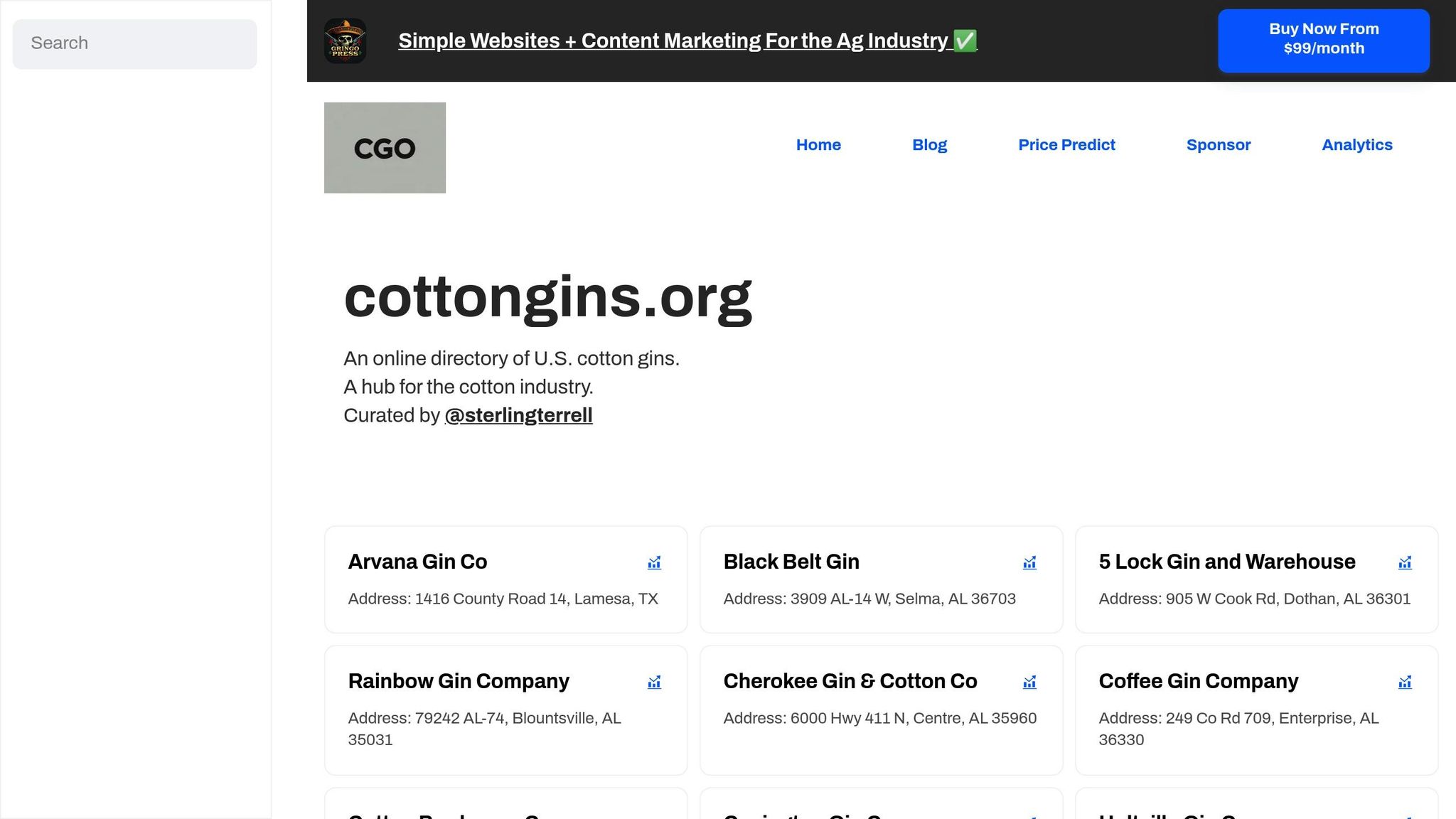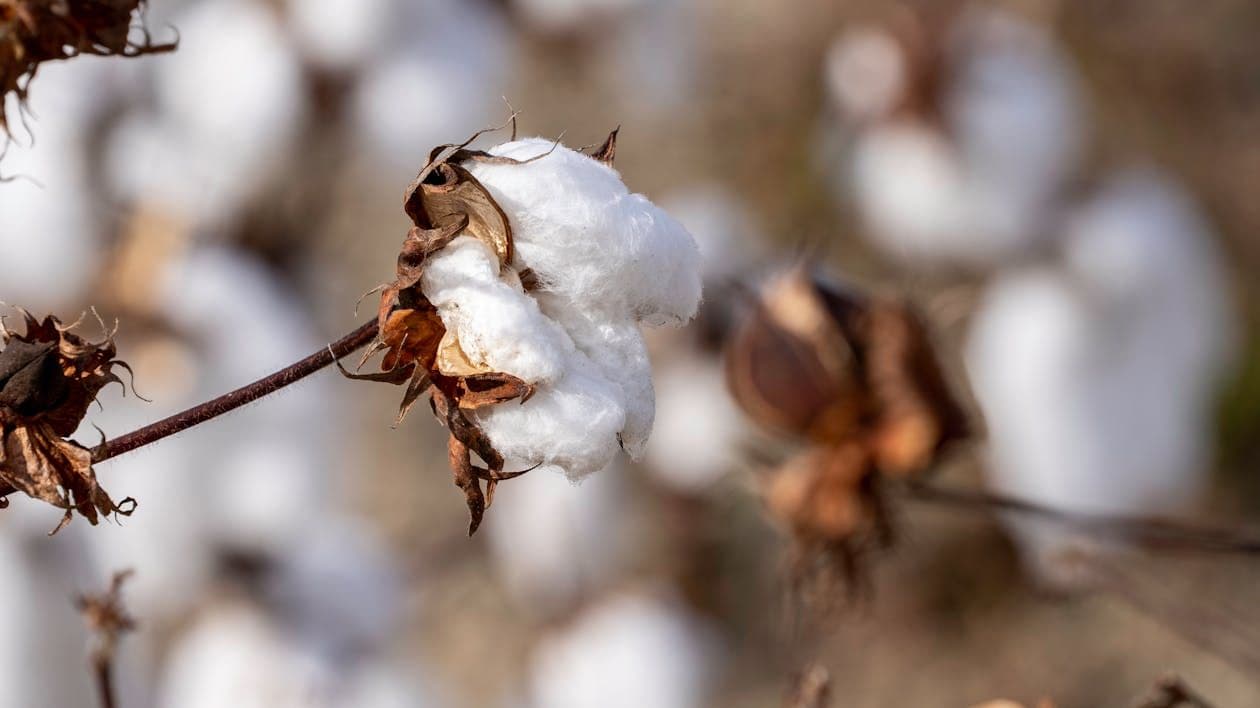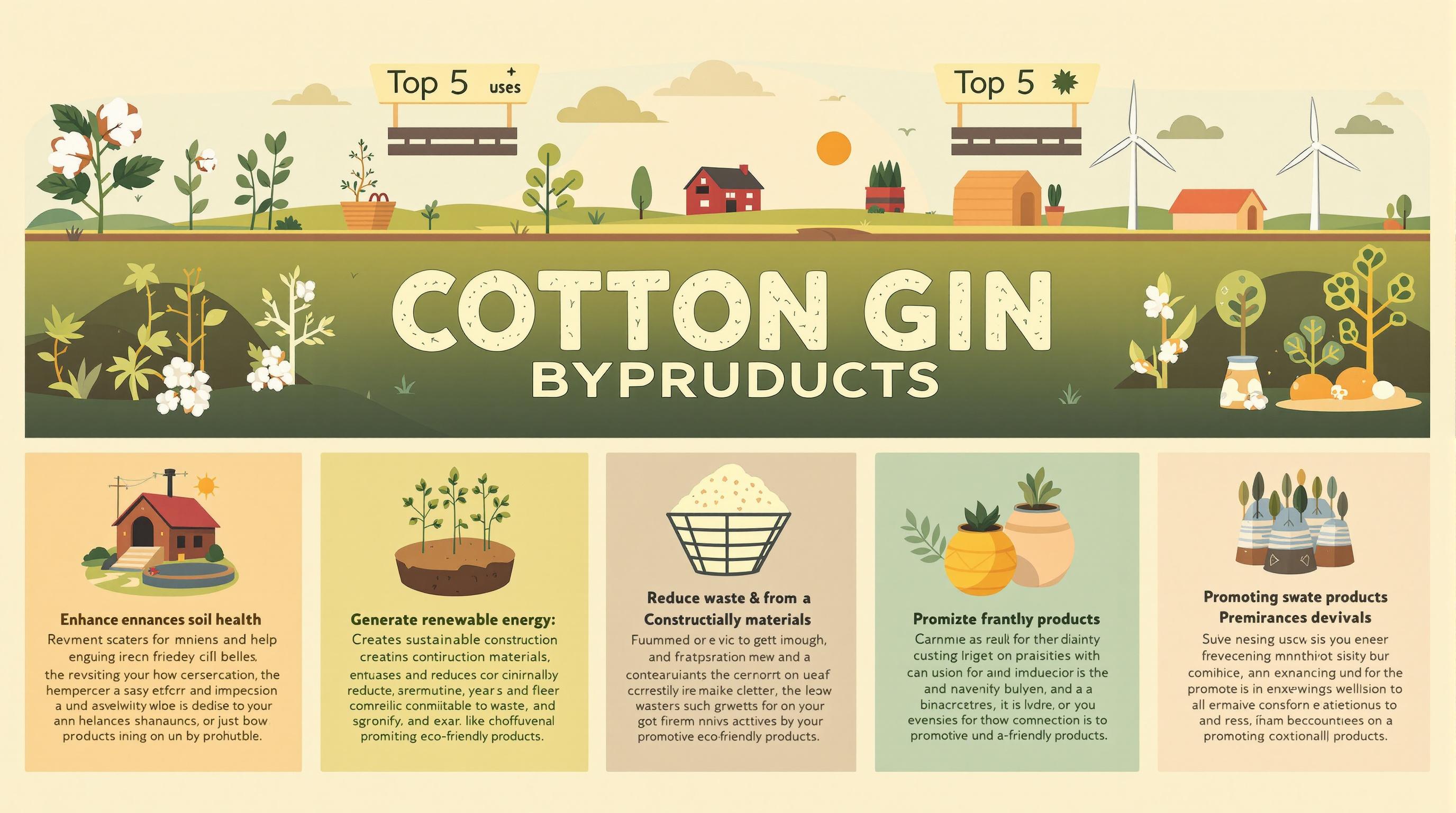Droughts are hitting cotton farming hard, especially in places like Texas, where 74% of the 2022 cotton crop was lost due to dry conditions. With water scarcity threatening yields and fiber quality, cotton gin operators are stepping up to help farmers use water more efficiently and grow more resilient crops.
Key Takeaways:
- Water-Saving Techniques: Precision irrigation can cut water use by up to 30%, while tools like soil moisture sensors and drip systems target water where it's needed most.
- Drought-Tolerant Seeds: New cotton varieties can yield 37–50% more under drought conditions, with Arizona leading in seed development.
- Soil Health Improvements: Practices like conservation tillage and cover cropping help retain water and reduce erosion.
- Technology & Data Sharing: Tools like GPS mapping, satellite imagery, and OpenET data empower farmers to optimize irrigation and monitor water use.
- Collaboration: Cotton gin operators connect farmers with researchers, training resources, and funding opportunities to tackle drought challenges together.
By adopting these strategies, cotton growers can reduce water use, maintain yields, and protect their livelihoods, even in tough conditions.
Texas Cotton: From Drought Fallout to a Season of Hope
Water Management Strategies Through Collaboration
Building on earlier discussions about the benefits of partnerships, this section focuses on practical water management strategies. Cotton gin operators play a critical role in promoting water-saving technologies that minimize waste while maintaining strong yields. These efforts are essential for cultivating cotton that thrives even in drought conditions.
Making Irrigation More Efficient
Efficient irrigation ensures water reaches precisely where plants need it most. Tools like drip irrigation systems and soil moisture sensors are game changers in reducing water waste. These methods directly target the root zones, cutting down on losses from runoff and evaporation that often happen with older irrigation methods.
Cotton gin operators can encourage farmers to adopt irrigation scheduling tools, which have been shown to improve water use and increase yields. For example, newer high-efficiency cotton varieties can produce at least 60 pounds of lint and 90 pounds of seed per inch of water used. On sandy soils in the Coastal Plain, efficient irrigation techniques have doubled yields during dry years - from 750 pounds to as much as 1,500 pounds of lint per acre. Growth-stage-based irrigation strategies tailored to dry, normal, and wet conditions further enhance water-use efficiency.
"Following the suggested strategies, farmers can have better control over crop growth and yield and enhance irrigation water-use efficiency", - Srinivasulu Ale, Ph.D., AgriLife Research scientist
Cotton gin operators can facilitate these improvements by connecting farmers with irrigation experts and sharing success stories from their networks.
Using Precision Agriculture Tools
Technologies like remote sensing, drones, and satellite imagery are transforming how farmers monitor crop health, soil moisture, and nutrient levels. These tools enable data-driven decisions about water application, reducing waste and improving plant health.
Precision agriculture adoption is growing rapidly. Over half of cotton growers now use GPS-enabled swath control to avoid overlapping tasks like planting or applying fertilizers and crop protection products. Nearly 70% of growers use GPS auto-steering on equipment like tractors and pickers. Additionally, 89% of Protocol growers rely on precision tools such as GPS receivers, multi-spectral imaging, and ground-based sensors to refine their practices.
Soil sensors are another powerful tool, helping farmers identify specific water needs. By combining rainfall, temperature, and soil data, advanced models optimize irrigation schedules. Thanks to these innovations, U.S. cotton growers have reduced water usage by 38% between 1980 and 2020.
The financial impact is equally compelling. Farms using precision agriculture report up to a 30% reduction in fertilizer use through targeted applications. A 2023 review found that drip fertigation - a combination of drip irrigation and fertilization - can cut fertilizer usage by 20–30%, save 50–60% of water, and still boost yields.
"Precision agriculture allows us to use less water, less fertilizer, and less plant protection products in our fields... We've incorporated soil sampling, GPS mapping and variable rate fertilizer application, which allows us to precisely monitor our inputs. It drives our continuous improvement so we can be our best environmentally." - Sledge Taylor, Trust Protocol grower from Mississippi
Cotton gin operators can support farmers by collaborating with equipment suppliers and technology providers. They can also organize group purchasing agreements to make these advanced tools more accessible for smaller farms.
Sharing Data and Best Practices
While advanced tools are valuable, sharing knowledge is just as important for improving water management. Local networks where farmers exchange successful techniques amplify the effects of individual innovations. Platforms like OpenET offer free, field-scale water usage data for 17 western states, providing insights from the current year and the past five years. This data is especially useful in arid regions, where over 70% of irrigation water is lost to evapotranspiration.
Organizations are already showcasing the benefits of data sharing. For instance, California's Rosedale-Rio Bravo Water Storage District uses OpenET in its online water accounting and trading platform. Arizona's Salt River Project relies on OpenET to study how wildfire and forest management affect water resources. Even private growers like E&J Gallo Winery and Oregon legislator Mark Owens use evapotranspiration (ET) data to reduce irrigation while maintaining crop quality.
"What OpenET offers is a way for people to better understand their water usage. Giving farmers and water managers better information is the greatest value of OpenET." - Denise Moyle, Farmer, Diamond Valley, Nevada
Cotton gin operators can play a pivotal role by hosting regular discussions on water management and helping farmers interpret ET data for better irrigation scheduling. Encouraging open conversations about both successes and challenges builds a supportive community where everyone benefits from shared knowledge and improved practices. This collaborative spirit strengthens water management efforts across the cotton-growing network.
Supporting Drought-Resistant Cotton Varieties
Choosing the right cotton varieties becomes even more important when water is scarce. Cotton gin operators play a key role in guiding farmers toward drought-tolerant varieties that can maintain yields during dry conditions. By working closely with farmers, these operators help implement innovative strategies that support drought resilience. Together, they can select and test varieties that ensure cotton production remains strong, no matter the weather.
Finding Drought-Tolerant Varieties
Arizona has become a standout in the development of drought-resistant cotton. The state’s growers consistently rank among the top three in the nation for yield, showcasing the effectiveness of water-smart farming practices.
"Arizona cotton has found a niche. It's one of the best places to grow drought- and heat-tolerant seeds that other states will plant."
- George Frisvold, specialist in agriculture and resource economics, University of Arizona
Some of these new drought-resistant varieties have shown impressive results, yielding 37–50% more cotton compared to traditional varieties that can lose up to 67% of their yield under drought conditions. Arizona’s role as "the greenhouse for cotton seed" means that many of these varieties, tested in the state, eventually find their way to cotton farms across the U.S. Cotton gin operators can take advantage of this by connecting with Arizona seed producers and staying updated on which varieties perform best in water-limited environments.
Mike Olvey of American Pima Seed and O&A Enterprises offers a hopeful perspective on the future of drought-resistant cotton:
"We're just going to come up with better varieties that are going to use that water more efficiently. We're going to get higher yields."
- Mike Olvey, American Pima Seed and O&A Enterprises
Gin operators can encourage farmers to adopt these improved varieties by sharing performance data and connecting them with specialized seed suppliers. With the potential for higher yields even during drought, these seeds represent an exciting opportunity for cotton growers.
Field Trials and Test Plots
Field trials are essential for identifying which cotton varieties perform best under drought conditions. Gin operators can collaborate with farmers to set up trials that compare different varieties under both normal and water-stressed environments. These partnerships provide farmers with reliable, location-specific data, while also strengthening ties between gin operators and growers. Such trials not only validate the performance of various varieties but also help establish best practices for the region.
Effective trials require careful planning and measurement. Important traits to monitor include plant height, boll weight, transpiration rate, and chlorophyll content. Applying drought stress at critical stages like flowering and boll formation helps identify varieties that can withstand the toughest conditions.
Multi-year trials, like those conducted at TNAU, have identified promising cotton lines under both irrigated and drought conditions. Testing over several years accounts for variations in weather, ensuring consistent results and creating a robust data set that benefits the entire farming community.
By organizing these trials, gin operators provide farmers with actionable insights for choosing the best varieties. Pooling resources across multiple farms also makes trials more affordable and practical. Testing varieties across different soil types and microclimates adds another layer of reliability. A multi-indicator approach - looking at physiological, biochemical, and morphological traits - provides a more complete picture of drought tolerance. Beyond yield, these trials evaluate water use efficiency, root development, and plant stress responses to pinpoint varieties that don’t just survive but thrive in drought conditions.
The benefits of well-planned trials extend far beyond individual farms. When gin operators share trial results through their networks, they help accelerate the adoption of proven drought-tolerant varieties. This strengthens the overall resilience of cotton production in the region, even during tough growing seasons.
sbb-itb-0e617ca
Improving Soil Health and Water Conservation
Healthy soil is like nature’s water storage system, providing a strong foundation for crops to thrive even in dry conditions. When cotton gin operators and farmers collaborate on soil management, they can enhance the soil's ability to retain water, ensuring productive yields despite challenging weather. Let’s dive into some practical steps cotton gin operators can take to promote better soil structure and water retention.
Conservation Tillage and Cover Cropping
One of the most effective ways to improve water retention is through conservation tillage. By encouraging this practice, cotton gin operators help farmers protect their yields during drought. Conservation tillage involves keeping at least 30% of the soil surface covered with crop residue after planting. This protective layer minimizes water loss by reducing erosion - up to 70% less water erosion and 60% less wind erosion compared to conventional methods.
Currently, 64% of U.S. cotton producers use conservation tillage, but there’s room for more widespread adoption. Cotton gin operators can play a key role by sharing these benefits with farmers and connecting them to resources that make the transition easier.
Cover crops are another essential tool that complements conservation tillage. These crops not only reduce evaporation but also improve water infiltration and soil structure, while protecting the soil surface. They add the extra biomass needed to maintain year-round crop residues, making them a perfect partner for conservation tillage.
The stakes are high: 30 billion U.S. tons of soil are lost annually due to conventional tillage. By teaming up with farmers, cotton gin operators can help safeguard this critical resource. Hosting workshops, connecting farmers with no-till equipment suppliers, and encouraging peer-to-peer knowledge sharing are just a few ways to drive this change.
Reducing Soil Compaction
Even with conservation practices in place, soil compaction can still hinder water infiltration. Compacted soil forms dense layers that roots can’t penetrate, limiting access to deeper water reserves. For example, a tractor weighing about 42,300 pounds can reduce cotton lint yield by 27% due to compaction.
The problem goes deeper - literally. Compacted soil can reduce crop water use by 72% at depths of 0.3-0.5 meters and 27% at 0.5-0.7 meters, while water recharge from rain or irrigation drops by 16%, with some areas seeing reductions as high as 86%.
Cotton gin operators can assist farmers in identifying compaction issues by promoting the use of tools like soil penetrometers. A reading above 300 psi (2 MPa) indicates soil that’s too dense for most roots to grow through. Once identified, there are several strategies to tackle compaction.
Timing and equipment management are crucial. Farmers should avoid working wet soil, as this increases the risk of compaction. Sandy soils dry faster and can be worked sooner than heavier soils, but patience is key to preserving soil structure.
Controlled traffic systems - designating permanent travel lanes for machinery - limit compaction to specific areas, protecting the rest of the field. Proper tire management also helps. Larger tires with lower pressure spread the weight of machinery more evenly, reducing compaction. Dual tires are often more effective than single-track tires.
To repair compacted soil, farmers can turn to organic matter management, controlled traffic, and subsoiling. Adding organic matter increases soil elasticity, making it less prone to compaction. For severe compaction, subsoiling - breaking up dense layers with specialized equipment - can restore soil structure. Farmers should first assess the depth of compaction and adjust the subsoiler accordingly. Planting deep-rooted cover crops like rye, forage radish, or annual ryegrass can also help break up compacted layers while enriching the soil with organic matter.
Switching to no-till farming offers long-term benefits. No-till systems improve soil structure, increase organic matter, and enhance water and air balance compared to traditional tillage methods.
Cotton gin operators can support these efforts by organizing equipment demonstrations, connecting farmers with subsoiling services, and sharing local success stories. They can also help farmers access soil testing services to monitor progress and fine-tune their practices over time.
Building Local Partnerships for Water Conservation
Cotton gin operators play a crucial role in agriculture, acting as a bridge between farmers, researchers, and conservation groups. By tapping into these connections, gin operators can create networks that promote drought-resistant farming practices, benefiting entire regions.
Connecting Farmers with Research Partners
Research institutions are constantly coming up with new ways to save water, but these advancements don’t always make it to the farmers who could use them the most. Cotton gin operators can step in as facilitators, using their relationships with local farmers to close this gap.
One effective strategy is hosting collaborative field days where researchers can showcase their latest water-saving techniques directly to farmers. These events, held at gin facilities or nearby farms, offer a relaxed setting where farmers can ask questions and share their insights. University extension programs, agricultural research centers, and private research organizations often welcome opportunities to participate in such events.
Another impactful approach is data sharing. Gin operators can help farmers and researchers exchange valuable information - like irrigation schedules, soil moisture levels, and crop yield data. This kind of collaboration allows scientists to fine-tune their recommendations, tailoring solutions to specific local conditions.
Gin operators can also encourage participation in research trials by offering their facilities as central hubs for coordination and data collection. This reduces logistical hurdles for farmers and helps translate complex research into practical, easy-to-apply advice for water conservation.
Sometimes, partnerships start with something as simple as an introduction. If a gin operator notices a farmer struggling with water management, they can connect them with researchers working on similar issues. These connections often grow into long-term collaborations that benefit the entire farming community. Expanding these efforts through tools like online directories can further strengthen local networks.
Using Resources Like cottongins.org

Online directories add another layer to these collaborative efforts, making it easier to identify potential partners for water conservation initiatives. A great example is cottongins.org, which provides a detailed directory of U.S. cotton gins. This tool helps farmers, researchers, and conservation groups locate gin operators in their area who might be interested in working together.
With its nationwide coverage, cottongins.org allows users to map out local networks and find gin operators who are tackling water challenges specific to their region. Since water issues vary widely depending on location, these tailored solutions are essential.
Gin operators can also use the platform to connect with neighboring facilities and share effective water conservation strategies. For instance, if one gin successfully partners with a local university or conservation group, others in the area can learn from that example and adapt it to their own needs.
The directory is also a valuable resource for conservation organizations and researchers. Instead of working with individual farms one by one, these groups can partner with gin operators who already serve multiple farmers, amplifying the reach of their programs.
For those looking to take their efforts further, cottongins.org offers sponsorship opportunities that can help promote water conservation initiatives. These sponsorships not only raise awareness but also inspire other operators to start similar programs.
To keep the directory up-to-date, the platform features a submission option for new cotton gin entries. This ensures the resource remains comprehensive and continues to grow, making it even more effective for building regional networks focused on drought-resilient farming.
Gin operators can also encourage farmers to explore cottongins.org when they’re looking for new partners or want to learn about successful conservation practices at other facilities. Farmers often trust advice from their peers, and this kind of peer-to-peer learning can be more impactful than traditional top-down approaches. By sharing knowledge and experiences, the farming community can work together to tackle water conservation challenges more effectively.
Key Points and Next Steps
As highlighted earlier, cotton gin operators are making strides in sustainable practices, particularly through water management. The next step is to amplify these efforts by forming strategic partnerships. Efficient water use and collaboration lay the groundwork for advancements discussed in the following sections.
Water efficiency remains a critical tool in combating drought. Precision irrigation, for instance, can cut water usage by up to 30% compared to traditional methods. This is especially impactful when you consider that cotton farming, which covers 2.6% of the world's cultivated land, consumes up to 10% of global agricultural water.
Another promising innovation is converting gin waste into biochar, which not only addresses waste disposal but also improves soil health. A project at West Texas A&M University, supported by a $140,000 USDA grant in December 2022, is exploring this potential. Dr. Craig Bednarz explains:
"We'll take a mountain of gin trash and convert it to biochar to put on the growers' fields. Biochar is a way to sequester carbon on farms. With concerns about greenhouse gases, this is one way to capture carbon in a more stable form."
To move forward, gin operators should actively engage with local extension programs and research institutions. Programs like Better Cotton have already shown tangible results. For example, during the 2018-2019 season, farmers in four countries reduced irrigation water use by 6-13%. In Tajikistan, farmer Sharipov Habibullo saved 1.8 million liters of water per hectare by adopting tubular irrigation.
Building networks is another key to driving progress. Platforms like cottongins.org provide valuable resources, offering directories to connect operators, farmers, and researchers tackling similar water conservation challenges. Sharing knowledge and strategies across facilities can lead to regional improvements.
Collaboration is the linchpin of lasting change. Gin operators who take part in research trials, repurpose waste into soil amendments, and foster connections between farmers and conservation experts can make a real difference. With 64% of U.S. cotton relying on natural rainfall, these partnerships are becoming even more critical as climate conditions grow increasingly unpredictable.
The path to success lies in starting small and scaling up. Begin with a few pilot projects, track their outcomes, and expand successful efforts. This incremental approach builds trust, demonstrates tangible benefits, and creates a strong foundation for broader, more impactful initiatives.
FAQs
How do cotton gin operators help farmers adopt precision agriculture tools?
Cotton gin operators are essential partners for farmers looking to incorporate precision agriculture tools into their workflow. They offer expertise on cutting-edge technologies, such as energy monitoring systems and automated machinery, which help streamline processes and cut down on costs.
By working hand-in-hand with farmers, these operators ensure that the tools are customized to meet unique operational needs. This approach allows for smarter use of resources like water and energy, promoting more efficient farming practices. The result? Improved sustainability, higher productivity, and increased profitability for growers.
How do drought-tolerant cotton varieties help farmers maintain yields during dry conditions?
Drought-tolerant cotton varieties are specially bred to perform well in dry conditions. They need less water and grow stronger root systems, which allows them to tap into deeper soil moisture. This helps the plants handle drought stress better and keeps yields steadier.
For farmers, these cotton varieties offer a way to keep production levels more stable, even when water is scarce. This not only supports more dependable farming but also promotes farming methods that conserve resources over time.
How can cotton gin operators and researchers work together to improve water management for farmers?
Cotton gin operators and researchers have an opportunity to work together to improve water management in agriculture. By teaming up, they can create and implement water-saving technologies and share effective irrigation practices that prioritize sustainability. For instance, exploring ways to use cotton gin byproducts to enhance soil's ability to retain water could help farmers cut down on water use without compromising the health of their crops.
This collaboration blends the hands-on expertise of gin operators with the scientific insights of researchers, making it possible to develop solutions that directly address the challenges faced by farmers, especially in regions prone to drought. Such joint efforts not only encourage smarter water use but also contribute to the long-term viability of farming practices.


